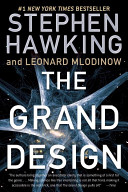M-Theory Describes a Universe That Creates Itself
If the total energy of the universe must always remain zero, and it costs energy to create a body, how can a whole universe be created from nothing. That is why there must be a law like gravity. Because gravity is attractive, gravitational energy is negative: One has to do work to separate a gravitationally bound system. such as the earth and moon. This negative energy can balance the positive energy needed to create matter, but it's not quite that simple. The negative gravitational energy of the earth, for example, is less than a billionth of the positive energy of the matter particles the earth is made of A body such as a star will have more negative gravitational energy, and the smaller it is (the closer the different parts of it are to each other), the greater this negative gravitational energy will be. But before it can become greater than the positive energy of the matter, the star will collapse to a black hole, and black holes have positive energy. That's why empty space is stable. Bodies such as stars or black holes cannot just appear out of nothing. But a whole universe can.
Because gravity shapes space and time, it allows space-time to be locally stable but globally unstable. On the scale of the entire universe, the positive energy of the matter can be balanced by the negative gravitational energy, and so there is no restriction on the creation of whole universes. Because there is a law like gravity, the universe can and will create itself from nothing in the manner described in Chapter 6. Spontaneous creation is the reason there is something rather than nothing, why the universe exists, why we exist. It is not necessary to invoke God to light the blue touch paper and set the universe going.
Why are the fundamental laws as we have described them.> The ultimate theory must be consistent and must predict finite results for quantities that we can measure. We've seen that there must be a law like gravity, and we saw in Chapter 5 that for a theory of gravity to predict finite quantities, the theory must have what is called supersymmetry between the forces of nature and the matter on which they act. M-theory is the most general supersymmetric theory of gravity. For these reasons M-theory is the only candidate for a complete theory of the universe. If it is finite—and this has yet to be proved—it will be a model of a universe that creates itself We must be part of this universe, because there is no other consistent model.
M-theory is the unified theory Einstein was hoping to find. The fact that we human beings—who are ourselves mere collections of fundamental particles of nature—have been able to come this close to an understanding of the laws governing us and our universe is a great triumph. But perhaps the true miracle is that abstract considerations of logic lead to a unique theory that predicts and describes a vast universe hill of the amazing variety that we see. If the theory is confirmed by observation, it will be the successful conclusion of a search going back more than 3,000 years. We will have found the grand design.
Notes:
How it does this, I don't fully understand from this passage.
Folksonomies: physics origins quantum physics m-theory
Taxonomies:
/science/physics (0.579998)
/law, govt and politics (0.362683)
/business and industrial/energy/electricity (0.286188)
Keywords:
negative gravitational energy (0.946724 (negative:-0.365558)), positive energy (0.800234 (negative:-0.378781)), gravity shapes space (0.560182 (positive:0.495900)), gravitationally bound system. (0.550159 (positive:0.320337)), black holes (0.544040 (negative:-0.515840)), universe (0.525347 (positive:0.501732)), vast universe hill (0.521867 (positive:0.984553)), general supersymmetric theory (0.519023 (positive:0.263400)), blue touch paper (0.515515 (positive:0.375468)), unified theory Einstein (0.506218 (positive:0.531344)), negative energy (0.468817 (neutral:0.000000)), matter (0.456487 (negative:-0.378781)), total energy (0.452207 (neutral:0.000000)), entire universe (0.429547 (positive:0.299879)), universe exists (0.429395 (negative:-0.244351)), different parts (0.429009 (neutral:0.000000)), black hole (0.422235 (negative:-0.346404)), grand design (0.421681 (positive:0.406852)), ultimate theory (0.420488 (negative:-0.349494)), Spontaneous creation (0.418836 (neutral:0.000000)), unique theory (0.418784 (positive:0.984553)), logic lead (0.417622 (positive:0.984553)), finite quantities (0.417527 (negative:-0.213791)), true miracle (0.417334 (positive:0.984553)), abstract considerations (0.417332 (positive:0.984553)), finite results (0.417182 (negative:-0.349494)), complete theory (0.417071 (neutral:0.000000)), successful conclusion (0.416579 (neutral:0.000000)), mere collections (0.416225 (positive:0.942612)), amazing variety (0.415789 (positive:0.984553))
Entities:
black holes:FieldTerminology (0.861482 (negative:-0.431122)), Einstein:Person (0.459601 (positive:0.531344)), 3,000 years:Quantity (0.459601 (neutral:0.000000))
Concepts:
General relativity (0.948633): dbpedia | freebase | opencyc
Universe (0.734261): dbpedia | freebase
Dark matter (0.638012): dbpedia | freebase
Physics (0.499123): dbpedia | freebase | opencyc
String theory (0.498883): website | dbpedia | freebase
Gravitation (0.463586): website | dbpedia | freebase
Potential energy (0.457586): dbpedia | freebase | opencyc
Fundamental physics concepts (0.428417): dbpedia





